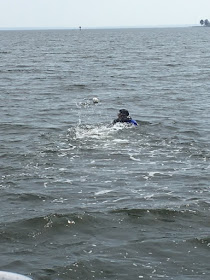Doesn't everyone go swimming in the Chesapeake in March (48F water)? A dry suit and hood make all the difference.
But how much force is actually delivered to the anchor, for how long, and does it work? So yesterday we headed out to a nice find sand bottom in Herring Bay and proceeded to "bump set" the anchor at different speeds (1-3 knots) and with two different bridles (both 35 feet long, but 8.3mm and 12 mm).
Eyeballs up-close will always be the best way to investigate an anchor. Normally I detest anchor buoys and tripping lines because of fouling potential, but they make finding the anchors and confirming geometry a lot easier when testing. Small fenders work, just be certain the float is not lifting the anchor!
Although I'm still crunching the numbers, the basic rules of thumb seem to be these:
- Only fine sand. Coarse sand takes a gentler hand, and soft mud requires long undisturbed periods and a soft hand.
- Long snubber, at least 30 feet. Try this with all-chain and you will pull the front of the boat off. The "whump" will also be to brief to move the anchor.
- About 1.5 knots for monohulls and about 2.5 knots for catamarans. This will be equivalent to 60 knots or wind, give or take, assuming the snubber design I posted in Practical Sailor.
- Two bumps is enough. The anchor didn't move appreciably after that.
- For outboard-powered boats and engineless boats only. If you have a good inboard, just set with that.
Before testing I ran all the numbers on an excel sheet, including all I have learned about rope elasticity, damping, anchors, and wind loads. When all of the data were collected and processed, it turns out the calculations were right and I had not learned anything that actually required field testing. But I like seeing actual numbers on a load cell.


No comments:
Post a Comment